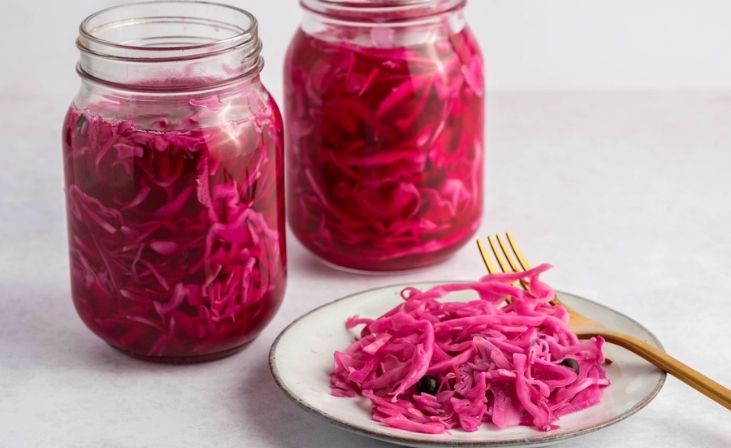Easy homemade sauerkraut recipe for beginners – Sauerkraut, a tangy and probiotic-rich fermented cabbage dish, has been a staple in diets around the world for centuries. Beyond its delicious flavor, sauerkraut offers a host of health benefits, including improved digestion and a boost to the immune system. The best part? You don’t need to be a seasoned chef to make your own batch of homemade sauerkraut. In this guide, we’ll walk you through a simple and beginner-friendly sauerkraut recipe that will have you enjoying the benefits of this nutritious dish in no time.
Table of Contents
ToggleHomemade Sauerkraut Recipe
Making your own sauerkraut at home is a fun and straightforward process, perfect for beginners. This easy homemade sauerkraut recipe will guide you through the steps to create a flavorful and gut-healthy condiment that can elevate your meals and promote digestive wellness.
Benefits of Homemade Sauerkraut
Before we dive into the recipe, let’s take a moment to appreciate the advantages of crafting your sauerkraut at home. While store-bought options can suffice, homemade sauerkraut shines in terms of freshness and ingredient control. Plus, it’s remarkably budget-friendly, requiring only a couple of basic ingredients and equipment.
Ingredients and Equipment
For this straightforward recipe, you’ll need just two primary ingredients: cabbage and salt. However, if you’re looking to add a personal touch, consider incorporating caraway seeds, juniper berries, or grated carrots to enhance the flavor profile. In terms of equipment, you’ll require a large bowl, a jar or fermentation crock, and a weight to keep the cabbage submerged during fermentation.
A Beginner’s Guide For Homemade Sauerkraut Recipe

Follow these instructions for homemade sauerkraut.
1. Prepare the Cabbage
Begin by selecting a firm, fresh cabbage. Remove the outer leaves, cut out the core, and slice the cabbage into thin shreds. The uniformity of the shreds will help with even fermentation.
2. Add Salt and Massage
In a large bowl, combine the shredded cabbage and salt. A general guideline is about 1 to 2 tablespoons of salt per medium-sized cabbage. Start massaging the cabbage with your hands, kneading and squeezing it to release its natural juices. This step is crucial as the cabbage’s juices create the brine essential for fermentation.
Also Read: Delicious Homemade Fermented Foods Recipes to Try
Don't just scroll, subscribe!
BuzzTrail's unique web-stories are the cure for boredom you've been waiting for.
3. Pack the Jar

Transfer the salted cabbage into your chosen fermentation container, packing it in layers. As you add each layer, press down firmly to eliminate any air pockets and encourage the cabbage to release more liquid. Keep reading for more information on Easy homemade sauerkraut recipe for beginners.
4. Weigh Down the Cabbage
Place a weight over the cabbage to ensure it remains submerged in its own juices. This prevents unwanted bacteria from forming on the surface. You can use a smaller jar filled with water or a dedicated fermentation weight for this purpose.
5. Cover and Ferment
Cover the jar with a clean cloth or a lid that allows gases to escape. Place the jar in a room-temperature environment, as the temperature impacts the fermentation duration. Warmer temperatures result in faster fermentation, while cooler temperatures slow it down.
6. Monitor and Taste

Keep an eye on your sauerkraut over the coming days. Check for any signs of mold or spoilage, though these are rare if you’ve maintained proper hygiene. After a few days, taste a small portion to monitor the flavor development.
7. Achieving Desired Fermentation
The fermentation time can vary based on your taste preferences. Generally, sauerkraut can be ready in as little as 1 week or as long as 4 weeks. During this time, you’ll notice the flavors transforming from tangy to intensely sour.
Tips for Success
After learning an Easy homemade sauerkraut recipe for beginners, here are some tips to get success.
- Keep all utensils, containers, and hands clean to prevent unwanted bacteria growth.
- Opt for non-iodized salt, as iodine can interfere with the fermentation process.
- Don’t be afraid to experiment with flavors by adding spices or other vegetables to the mix.
- Storing and Enjoying Sauerkraut
- Once your sauerkraut has reached your desired level of fermentation, transfer it to the refrigerator or a cool, dark place to slow down the fermentation process. Enjoy your homemade sauerkraut as a condiment, in sandwiches, salads, or even cooked dishes. The possibilities are endless!
Conclusion
In this blog, we have discussed Easy homemade sauerkraut recipe for beginners. Making your own sauerkraut from scratch might seem intimidating at first, but with this easy-to-follow recipe, even beginners can master the art of fermentation. The health benefits, cost-effectiveness, and the sense of accomplishment you’ll gain from crafting your sauerkraut are well worth the effort.
So, roll up your sleeves, embrace the process, and embark on your journey to creating delicious and nutritious homemade sauerkraut. Your taste buds and gut will thank you!
FAQs (Sauerkraut Recipe)
How long does homemade sauerkraut last?
How long does homemade sauerkraut last?
Homemade sauerkraut can last for several months when stored in a cool, dark place like your pantry. Once you open a jar, keep it in the refrigerator to extend its shelf life for up to six months or more.
Can I use different types of cabbage for sauerkraut?
Can I use different types of cabbage for sauerkraut?
Absolutely! While green cabbage is the classic choice, you can experiment with red cabbage, Napa cabbage, or a combination for unique flavors and colors in your sauerkraut.
Why is sauerkraut good for you?
Why is sauerkraut good for you?
Sauerkraut is a probiotic food rich in beneficial bacteria that support a healthy gut microbiome. It can aid digestion, boost immunity, and provide essential nutrients like vitamin C.
What if my sauerkraut tastes too salty?
What if my sauerkraut tastes too salty?
If your sauerkraut turns out overly salty, you can dilute it with additional cabbage or rinse it briefly with cold water before serving. Adjusting the salt content in your next batch can also help control the saltiness.

